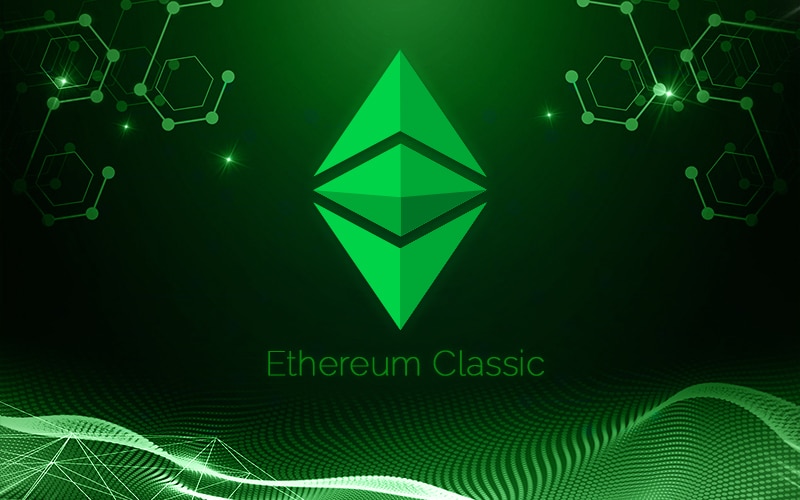The Ethereum Classic (ETC) cryptocurrency emerged as a result of the hard fork of Ethereum after the DAO hack in July 2016. During this period, the coin managed to reach great heights, overtaking many tokens that had very strong positions in the cryptocurrency market.
Origin and Development
ETC is not a new cryptocurrency in the full sense of the word, but is the result of an Ethereum hard fork. The blockchains of both tokens are completely identical at all points, up until the block 1,920,000 when the network split occurred.
Ethereum Classic has similar functionality to ETH, including creating and running smart contracts and decentralized applications. However, ETC does have some features that differentiate it from its ‘big brother’, including average block time, block size and rewards for miners.
Ethereum Classic mining pools were formed after the Ethereum hard fork, and the coins were traded on several exchanges. At the same time, the ETC community grew quickly, adhering to Ethereum’s initial vision of becoming the world computer.
Because the Ethereum Classic Mainnet is not proposed to convert to PoS, therefore the Difficulty Bomb was removed to prevent the network from collapsing. As a result, at block 5,900,000, the ECIP proposed defusing the Difficulty Bomb from the Ethereum Classic Mainnet.
The ETC client is being maintained by several teams, each responsible for specific actions:
- ETC Dev Team (led by Igor Artamonov – responsible for creating Geth Classic in the Go language);
- Ethereum Commonwealth (is developing ERC223 under the leadership of an anonymous developer having the pseudonym Dexaran);
- IOHK Grothendiek (working on a Scala client; the team is led by Charles Hoskinson);
- EthCore (led by Gavin Wood, who co-founded ETH along with Vitalik Buterin; was responsible for writing Yellow Paper; later created EthCore and developed the Parity client).
Fall of The DAO
After two years of Ethereum operation, the community decided to launch DAO. The Decentralized Autonomous Organization (DAO) was designed to act as a decentralized venture capital fund for crypto projects. The idea was to create a decentralized organization with no country-specific linkage, no board of directors or staff. Instead, the plan was to use independent investors as key participants.
In May 2016, the DAO launched an ICO to raise funding for its development. With the intention of raising $150 million, it became the second largest crowdsale in the history of the cryptocurrency ecosystem.
Soon after, hackers discovered and exploited a bug in the DAO code, stealing more than $50 million. This led to a commotion among the project’s investors, especially among members of the Ethereum community, and the subsequent decision to fork it.
Reasons for Ethereum Classic creation
The hard fork was a controversial decision that split the ETH community into two opposing camps. Preparations for the split took place amidst heated discussions.
At the time of the DAO incident, Ethereum was in its infancy. The price of the token had plummeted. The attackers were using the DAO code, not the Ethereum. Nevertheless, ETH had to pay the price for its involvement with the DAO in terms of its reputation and market valuation. This shattered people’s faith in digital currency in general.
As a result, the majority of the Ethereum community decided to hold a hard fork to recover the financial losses and reputation among investors. The hard fork was implemented on the Ethereum blockchain, making the hacked transaction invalid. Then, a new version of the blockchain was formed.
Thus, Ethereum Classic was created.
Difference between Ethereum and Ethereum Classic

ETC runs on a protocol that performs similar functions to the original ETH with some differences. It is actively traded on exchanges and is popular with altcoin traders.
Ethereum can be compared more to an aspiring company that may have to make more than one hard fork in the future. Ethereum owes its value primarily to traders for their activity, but also to the fact that it is in an alliance with companies like Accenture, JP Morgan, Microsoft and UBS. This supports it well.
Both coins have their advantages and disadvantages, but ETH remains the leader for now as it has a larger market capitalization.
In addition, there are other differences:
- Blockchain volatility – The Ethereum blockchain is modifiable while the ETC blockchain records are not.
- Development features – Most of the solutions are initiated by the Ethereum Foundation. In Classic, the bulk of the solutions are the result of three teams with not much cohesion and feedback from the community.
- Compatibility – So far, the two networks are compatible, so smart contracts written in one can run in the other. Additionally, Ethereum is aiming for openness in its platform through eWASM pushing the issue of contract security to the back burner. ETC puts more emphasis on smart contracts with high security.
- Blockchain processing – This process takes around 25 seconds for Ethereum and 14 seconds for Ethereum Classic.
- Monetary policy – The planned lifetime inflation rate for ETH is 3% per year. In ETC, the same level is planned until around 2025, after which the coin will become deflationary.
Where to buy Ethereum Classic
Buy ETC on many exchanges, both for fiat money and for other cryptocurrencies.
The best classic exchanges to buy and sell Ethereum:
- Binance
- Poloneix
- Shapeshift
- Bitfinex
- Bittrex
- Kraken
- Bitsquare
Where to store Ethereum Classic
For both storing and mining Ethereum Classic, you will need a wallet. The list of the most popular ETC wallets includes:
- Specialized ETC wallet (online)
- Multi-currency Classic Ether Wallet (online)
- Trezor (hardware)
- Ledger Nano S (hardware)
- Jaxx (mobile and desktop)
How to mine Ethereum Classic
Lately, the number of users who are switching to ETC mining has increased significantly. The most popular way to mine this coin is via mining pools, which allows you to increase your power along with other participants. The most popular services are listed below :
- Coin-Miners
- Suprnova
- MinerGate
- EthTeam
- Epool
- Nanopool
Project evaluation and perspectives
Ethereum was chosen by an overwhelming majority of the crypto community. It’s worth emphasizing that ETH, which supports innumerable ideas and opportunities, would not exist today if not for the hard fork.
Ethereum’s strength lies in its community, as it is a platform that allows the creation of projects that can revolutionize almost any industry.
Ethereum Classic, in contrast, has a tarnished reputation because of its history with DAO. The “code is law” principle has de facto justified the theft of funds from the community. The basic idea of DAO could have had a significant impact on future technologies, but it turned out that its fall spawned a more robust platform for Ethereum developers.
Nevertheless, Ethereum Classic still has a strong community of committed supporters including prominent developers and crypto enthusiasts. After the hard fork, the project was not abandoned, as many expected, but survived several major updates. So, the Ethereum Classic continues to evolve, albeit not as actively as Ethereum.
ETC’s popularity is also supported by the profitability of mining this coin, especially because Vitalik Buterin announced that Ethereum will most probably switch to Proof of Stake algorithm in August 2022, after which miners will not be able to make profits from ETH.
There is every reason to believe that Ethereum Classic will grow in popularity and price for the foreseeable future, though it is unlikely to catch up with Ethereum.
Read more updates on Ethereum






